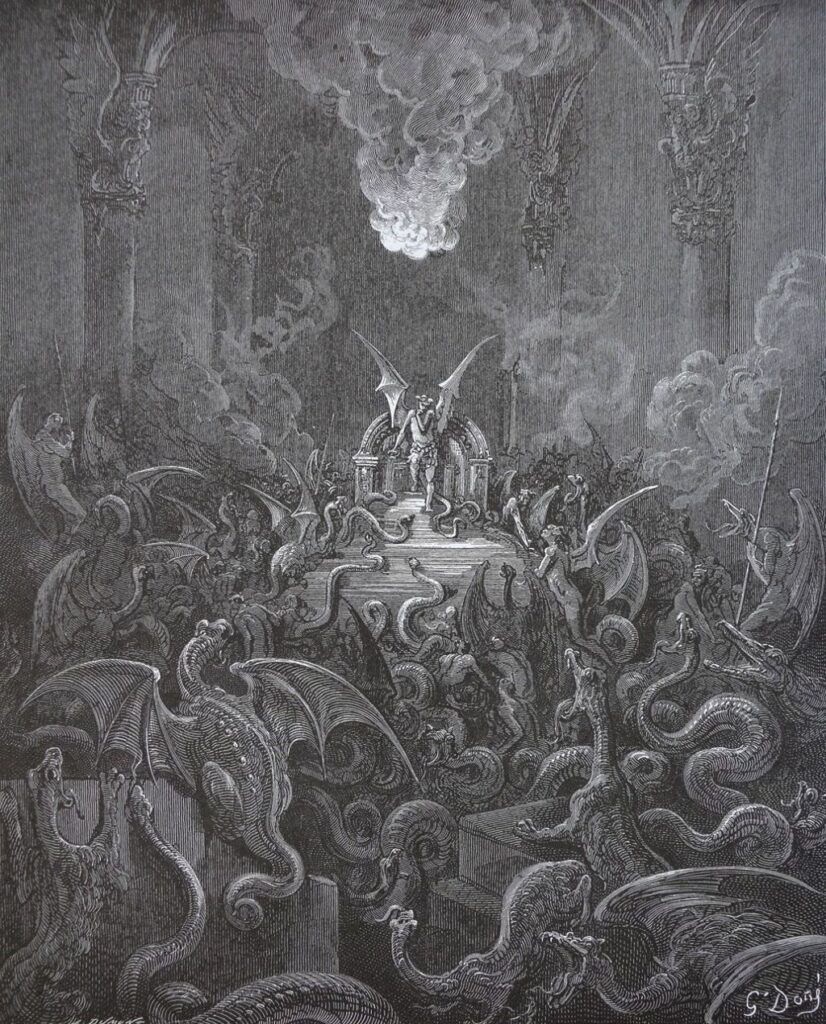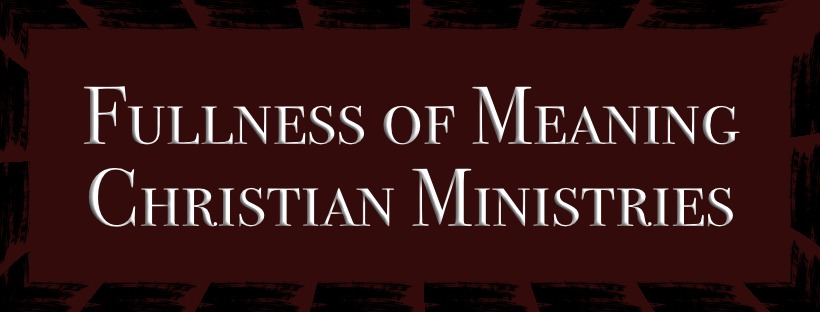The key meaning of evil is that ‘something that doesn’t *fit* into an expected boundary line and/ or a specific arena’. That is, evil can be defined as a violation within a specific field where rules apply and violations warrant penalties. Penalty boxes, prisons, slums, vagrancies, outcasts, wanderings, ….whatever is ‘outside’ the ‘legal box’ of comfiture is ‘evil’ by definition–especially, in the sense of derogation from which they are called ‘places of penalty’.
Evil is the mental, social, spiritual discomfiture created by the person or entity supposed to not make a disturbance. A “misfit”. “Unskillful” is another etymological match for ‘evil’. “Awful” has left its first meaning of “full of awe/ wonderment” for the ‘horrid’ sense (which we will address later in the meaning of “monster”). Moreover, the ‘inability’ to *fit* into some kind of “normalcy” that is expected is what the Middle Ages called, “ugly” or “non-cosmetic”. “Cosmos” was understood as the ‘arrangement’ within the creation. Later Medieval society became influenced by Neo-Platonism and a revival classicism. This revival influenced many medievals to look at society as the mirror of the cosmos. Therefore, ‘orderly arrangement’ of society had a sense of ‘beauty’ as did the ‘symmetry’ or ‘organized sense’ of a woman’s face did. A non-symmetrical face or a face that didn’t meet the criteria for ‘that which was befitting the cosmos of the day’ was considered ‘ugly’. Such as a bent nose, crooked face, arms, legs, back, etc. were all looked at as possible ‘evils’ or ‘non-compliant’ bodies that their very souls were shaped to. Such as the idea of a witch being ‘ugly’, or one of a non-compliant nature. The Medieval conceived a moral harmony within their cosmogony that matched their metaphysics and participation or figuration of what was physically beautiful within their societal schema.

We find this meaning of ‘ugly’ to fit very cleanly into the concept of ‘evil’, relative to the societal standard and how both, the ‘evil/ ugly’ one is in relation to the society that has established it’s ‘cosmetics, cosmology, cosmos’ to judge by. These ‘high one’ are the gods, the stars, the heavenlies by which they ‘cast’ their doom, dominion, bane upon the ‘lowest’.
Ugly, means ‘frightful in appearance, dreadful, fearful’ in the Old Norse word, “uggligr”. It’s deeper Germanic root, “uggr” – “fear, apprehension, dread, etc,” leads me to the related European and Greek, “ang”- for ‘angst, anguish, etc.. I find “ogre” as an ugly outcast in this Germanic word. Furthering its root, “strife, hate” are a part of this morphological sequence. In the 1400s, ‘morally offensive’ and by the 1600s- ‘ill-tempered’ became part of the coterie of meaning for this *ugly* word. Going back now into the classical sense of beauty to the Greeks and Romans, the Greek holds, “Dyseides”, while the Latin, “deformis”. Earlier, the Sanskrit, “ku-rupa’’.
In fictive, legendary, fantastic or fantasy writings, we find the ‘dark one’ or evil forces’ that dwell amongst the heath, the moors, the outskirts, the ‘pegged-off’ areas (hence, the word for ‘pagan’.. ‘the one who lives where the *pegs* demark the outlanders, outliers, outsiders’). As an example found in Beowulf, we see the deformed and monstrous and deformed, *Grendel*, and his witch mother dwelling amongst the moors or the outskirts of society (outside the boundary line). The same typology of ‘evil’ and/ or ‘ugly’, is found with the dwarves in sleeping beauty, Princess and the Goblin, the movies and stories in Sherlock Holmes’, “the Hounds of Baskerville” or the cult movie classic, “The Wolfman”, from which both stories tell us to not walk amongst the moors at night. That is, the ugly ones dwell away from the society where another type of cosmos can be employed. A netherworld, “Sheol (Hebrew: “unseen”)”, “Hell (“hole”–hole in the ground/ unseen place)”, Phulake (Greek) – a prisoner’s watch at night that later became known as the prison itself at night or a ‘dark prison’.
It is in the truest meaning of “evil” that we find it in it’s parent stock: “hupo”. We get our word, ‘hyper’, from this. Halfway joking, we can see ‘evil’ through our children–as, ‘little devils’, when our children get ‘too hyper’—that is, ‘unruly within the understood status quo’ of how to manner or conduct oneself within the economy or household law.
Yet another sense of evil is our Greek word, “Huperephano”, “to shine above others”. This Greek word is considered to be akin to what the term, Lucifer meant in it’s derogatory sense. “Lux” – “light”/ “ferus” – ‘to bring’. Nothing wrong with that word in its original constitution. It literally means, “to bring light’’. This is very much the title of action for the God of Light, or, in Christian terms, Christ, the light bearer. But, in the pseudo light bearer, we have the active sense, “demon”, or, “bringer/ dispenser of the shining (silver/ gold/ riches/ jewels/ fortunes)”. The ‘allotments’ desired for by the fleshly want versus the ‘need’ for what the whole, organic, pure soul needs.
This ‘conduct’ might be the framework from which we can gauge just what is evil.
It is in the primal root, “hupo”, that we see the meaning, “overreaching”, “excessive”, “above”, “beyond”, “outside”, the boundary lines of what is acceptable, legal, normal, understood conduct.
This ‘overreaching’ does indeed touch on the Hebrew concept of ‘boundary line’. The boundary line for where sheep graze and eat the grass permitted for them is considered the legal grazing area. Anything passed the ‘boundary’ of legal grazing is considered ‘animos’ in the Greek—or, ‘anti-law’. To go deeper, the Proto-Indo-Europeans gave us the root, “*ane-”, which means, “to breathe”/ as “life, breath”….as an “animal”…hence, the Latin, animositatem – “boldness, vehemence, spirited”–animosity, as our modern usage is concerned, could fall in line with this older root. As, “ane-”, in the European sense means ‘to breathe’ (with its declination of morality following in later years), so does the Hebrew sense for, “Breath, Breathe, passion, heat, sexuality, war, fight, eros, etc.” hold its own very akin and similar meaning to the Indo European, “ane-”. The Hebrew word, “Aph”, means, “nostrils”….but, the declination can follow and does give itself to the primal function verses the Heavenly senses found alongside the Greek *Ouranos* and Hebrew *Shemayim*.
Culturally speaking, we find one of the terms for ‘evil’ in the Hebrew word, “A-ghl”, which means, “evil”; “black-wild goat” or “wild-goat”. A wild goat eats everything. A wild goat cannot be contained and holds a type of ‘animosity’ to anything that would hold it to a ‘boundary’ area. It roams, it bucks, it kicks, it is ornery. Shepherds, such as Phillip Keller (who wrote a book on this very topic of shepherding) know that it is very important to keep all sheep inside the legal boundaries. If a sheep has a nature to break that boundary line it can lead other sheep astray with it. We know that the sheep’s wool can collect enough trash, bramble, sticks, etc. that given enough time, the sheep will simply become top heavy, fall over/ become ‘cast’, and its natural gases will be trapped in its rumen or paunch where it will die to the dysfunction of eructation (expelling of carbon dioxide, methane and some hydrogen). This fate will happen to all the sheep if proactive measures are not taken to keep them in the boundary or legal feeding zone.
It is in the Hebrew culture, and the language for which the culture is expressed most actively/verbally that we have the concept of the ‘boundary line’. Heaven is measured by the ‘boundary line’ from which the earth meets the sky. At the end of the line. The boundary of the “EYES” of God, or the “APPLE” of God’s eye is the “sheep gate”, the “beloved”, “the watched”.
I find it interesting that the “raven’s eye” is called the “witches eye” in some pagan literature. I find it most interesting to see that ODIN is written to have two Ravens on his shoulders. That “one-eyed’’ God whose name is very close to, “Adonai”, whose Ravens saw for him, roved for him…Much as the Satan ‘roved-to and fro’ looking for those to sift for God in the Book of Job.
It was in the Barnes and Nobles edition of Norse Mythology that I read, to my shock, that authorities/ scholars on Norse Myths do believe that its origins came from the Iranian Plateau which is exactly where many leading archeological scholars believe Adin or Eden was physically located, by name! … Even east of this region was recovered the area of “Nochti”–southern/ northern (a.k.a., “Nod”), a local tribal city within this very region called, “badh-tibira”, or the ‘place of the smithy/ black smith’ — i.e., “artificer of metals” —Cain/ Genesis 4:22.
